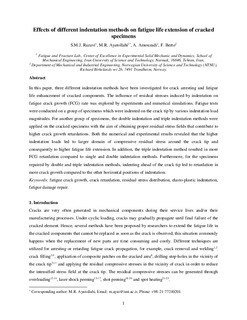| dc.contributor.author | Razavi, Seyed Mohammad Javad | |
| dc.contributor.author | Ayatollahi, Majid reza | |
| dc.contributor.author | Amozadi, Atefeh | |
| dc.contributor.author | Berto, Filippo | |
| dc.date.accessioned | 2018-12-10T12:57:09Z | |
| dc.date.available | 2018-12-10T12:57:09Z | |
| dc.date.created | 2018-09-04T11:14:06Z | |
| dc.date.issued | 2018 | |
| dc.identifier.citation | Fatigue & Fracture of Engineering Materials & Structures. 2018, 41 (2), 287-299. | nb_NO |
| dc.identifier.issn | 8756-758X | |
| dc.identifier.uri | http://hdl.handle.net/11250/2576964 | |
| dc.description.abstract | In this paper, 3 different indentation methods have been investigated for crack arresting and fatigue life enhancement of cracked components. The influence of residual stresses induced by indentation on fatigue crack growth (FCG) rate was explored by experiments and numerical simulations. Fatigue tests were conducted on a group of specimens which were indented on the crack tip by various indentation load magnitudes. For another group of specimens, the double indentation and triple indentation methods were applied on the cracked specimens with the aim of obtaining proper residual stress fields that contribute to higher crack growth retardations. Both the numerical and experimental results revealed that the higher indentation loads led to larger domain of compressive residual stress around the crack tip and consequently to higher fatigue life extension. In addition, the triple indentation method resulted in more FCG retardation compared with single and double indentation methods. Furthermore, for the specimens repaired by double and triple indentation methods, indenting ahead of the crack tip led to retardation in more crack growth compared with the other horizontal positions of indentation. | nb_NO |
| dc.language.iso | eng | nb_NO |
| dc.publisher | Wiley | nb_NO |
| dc.title | Effects of different indentation methods on fatigue life extension of cracked specimens | nb_NO |
| dc.type | Journal article | nb_NO |
| dc.type | Peer reviewed | nb_NO |
| dc.description.version | submittedVersion | nb_NO |
| dc.source.pagenumber | 287-299 | nb_NO |
| dc.source.volume | 41 | nb_NO |
| dc.source.journal | Fatigue & Fracture of Engineering Materials & Structures | nb_NO |
| dc.source.issue | 2 | nb_NO |
| dc.identifier.doi | 10.1111/ffe.12678 | |
| dc.identifier.cristin | 1606521 | |
| dc.description.localcode | This is the pre-peer reviewed version of the article which has been published in final form at [https://doi.org/10.1111/ffe.12678]. This article may be used for non-commercial purposes in accordance with Wiley Terms and Conditions for Self-Archiving. | nb_NO |
| cristin.unitcode | 194,64,92,0 | |
| cristin.unitname | Institutt for maskinteknikk og produksjon | |
| cristin.ispublished | true | |
| cristin.fulltext | preprint | |
| cristin.qualitycode | 2 | |
